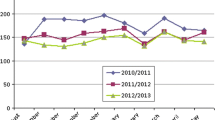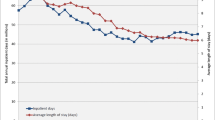Abstract
BACKGROUND: In response to proposed federal legislation, the Accreditation Council for Graduate Medical Education limited resident work-hours in July 2003. The cost may be substantial but, if successful, the reform might lower preventable adverse event costs in hospital and after discharge.
OBJECTIVES: This study sought to estimate the reform’s net cost in 2001 dollars, and to determine the reduction in preventable adverse events needed to make reform cost neutral from teaching hospital and societal perspectives.
DESIGN: Cost analysis using published literature and data. Net costs were determined for 4 reform strategies and over a range of potential effects on preventable adverse events.
RESULTS: Nationwide, transferring excess work to task-tailored substitutes (the lowest-level providers appropriate for noneducational tasks) would cost $673 million; mid-level providers would cost $1.1 bi|lion. Reform strategies promoting adverse events would increase net teaching hospital and societal costs as well as mortality. If task-tailored substitutes decrease events by 5.1% or mid-level providers decrease them by 8.5%, reform would be cost neutral for society. Events must fall by 18.5% and 30.9%, respectively, to be cost neutral for teaching hospitals.
CONCLUSIONS: Because most preventable adverse event costs occur after discharge, a modest decline (5.1% to 8.5%) in them might make residency work-hours reform cost neutral for society but only a much larger drop (18.5% to 30.9%) would make it cost neutral for teaching hospitals, unless additional funds are allocated. Future research should evaluate which reform approaches prevent adverse events and at what cost.
Similar content being viewed by others
References
Accreditation Council for Graduate Medical Education. ACGME Duty Hours Standards Now In Effect for All Residency Programs, July 1, 2003. Available at: http://www.acgme.org/Media/NewsRelease.asp. Accessed May 18, 2004.
Steinbrook R. “The debate over residents” work-hours. N Engl J Med. 2002;347:1296–302.
Accreditation Council for Graduate Medical Education. The ACGMEs Role in Protecting Education, Patient Safety and Resident Safety: ACGMEs Response to HR 3236 and Similar Calls for Regulation to Address Resident Hours. Available at: http://www.acgme.org/New/conyerscom.pdf. Accessed May 18, 2004.
Philibert I, Friedmann PI, Williams WT. New requirements for resident duty hours: report of the ACGME Work Group on Resident Duty Hours. JAMA. 2002;288:1112–4.
DeBuono BA, Osten WM. The medical resident workload: the case of New York State. JAMA. 1998;280:1882–3.
Millenson ML. Pushing the profession: how the news media turned patient safety into a priority. Qual Saf Healthcare. 2002;11:57–63.
Kohn L, Corrigan J, Donaldson M. To Err Is Human: Building a Safer Health System. Committee on Quality of Healthcare in America. Institute of Medicine. Washington, D.C.: National Academy Press; 1999.
The Agency for Healthcare Research and Quality. Patient Safety Research Initiatives: Fiscal Year 2001. Available at: http://www.ahrq.gov/qual/ps2001.htm. Accessed May 18, 2004.
Congressional Text Record. Thomas: Legislative Information on the Internet. Available at: http://thomas.loc.gov. Accessed May 16, 2005.
Gurjala A, Lurie P, Haroona L, et al. Petition to the occupational safety and health administration requesting that limits be placed on hours worked by medical residents (HRG Publication #1570). 2001. Available at: http://www.citizen.org/publications/print_release.cfm?ID=6771. Accessed March 11, 2003.
Conyers J, Waxman HA, Stark FP, et al. H.R. 3236, Patient and Physician Protection Act of 2001. 107th Congress, 1st Session.
Accreditation Council for Graduate Medical Education. Resident duty hours language, final requirements, February 13, 2003. Available at: http://www.acgme.org/DutyHours/dutyHoursLang_final.asp. Accessed May 18, 2004.
Conyers J. H.R. 1228, Patient and Physician Protection Act of 2003. 108th Congress, 1st Session.
Corzine JS. H.R. 952, Patient and Physician Protection Act of 2003. 108th Congress, 1st Session.
Thomas EJ, Studdert DM, Newhouse JP. Costs of medical injuries in Utah and Colorado. Inquiry. 1999;36:255–64.
Whang EE, Mello MM, Ashley SW, Zinner MJ. Implementing resident work hour limitations: lessons from The New York state experience. Ann Surg. 2003;237:449–55.
Cole DJ, Bertagnolli MM, Nussbaum M. Society of university surgeons statement on surgical resident work-hours and education. Surgery. 2002;132:115–8.
Darosa DA, Bell RHJ, Dunnington GL. Residency program models. implications, and evaluation: results of a think tank consortium on resident work-hours. Surgery. 2003;133:13–23.
Greenfield LJ. Limiting resident duty hours. Am J Surg. 2003;185:10–2.
Weinstein DF. Duty hours for resident physicians—tough choices for teaching hospitals. N Engl J Med. 2002;347:1275–8.
Zhan C, Miller MR. Excess length of stay, charges, and mortality attributable to medical injuries during hospitalization. JAMA. 2003;290:1868–74.
Philibert I, Vasilias J. Accreditation Council for Graduate Medical Education. An Annotated Bibliography of Selected Articles on Resident and Physician Duty Hours. August 2002. Available at: http://www.acgme.org/DutyHours/dutyHrs_Index.asp. Accessed November 11, 2003.
Veasey S, Rosen R, Barzansky B, Rosen I, Owens J. Sleep loss and fatigue in residency training: a reappraisal. JAMA. 2002;288:1116–24.
Boex JR, Leahy PJ. Understanding residents’ work: moving beyond counting hours to assessing educational value. Acad Med. 2003;78:939–44.
Jha AK, Duncan BW, Bates DW. Fatigue, sleepiness, and medical errors. In: Shojania KG, Duncan BW, McDonald KM, Wachter RM, eds. Making Healthcare Safer: A Critical Analysis of Patient Safety Practices, Vol 43. Rockville, Md: Agency for Healthcare Research and Quality; 2001; 519–33.
Gaba DM, Howard SK. Patient safety: fatigue among clinicians and the safety of patients. N Engl J Med. 2002;347:1249–55.
Accreditation Council for Graduate Medical Education. A glossary of selected terms, essentials of accredited residencies in graduate medical education, Section II, GME Useful Information. Available at: http://www.acgme.org/GmeDir/Sect2.asp#gloss. Accessed May 18, 2004.
Accreditation Council for Graduate Medical Education. Number of all accredited programs for a specific academic year (excluding combined programs). June 30, 2002. Available at: http://www.acgme.org/adspublic/reports/accredited_programs_2001.html. Accessed March 10, 2003.
Knickman JR, Lipkin MJ, Finkler SA, Thompson WG, Kiel J. The potential for using non-physicians to compensate for the reduced availability of residents. Acad Med. 1992;67:429–38.
Schwartz RJ, Dubrow TJ, Rosso RF, Williams RA, Butler JA, Wilson SE. Guidelines for surgical residents’ working hours. Intent vs reality. Arch Surg. 1992;127:778–82 (discussion 782-773).
Scher KS, Peoples JB. A study of the on-duty hours of surgical residents. Surgery. 1990;108:393–7.
Stoddard JJ, Kindig DA, Libby D. Graduate medical education reform. Service provision transition costs. JAMA. 1994;272:53–8.
Dolan KL, Rosner F, Spiegel K. Survey of nonphysician tasks performed by medicine residents at a municipal hospital. J Natl Med Assoc. 1990; 629–33.
U.S. Department of Labor: Bureau of Labor Statistics. 2001. National occupational employment and wage estimates: healthcare practitioners and technical occupations. Available at: http://www.bls.gov./oes/2001/oes_29He.htm. Accessed December 12, 2002.
U.S. Department of Labor: Bureau of Labor Statistics. 2001. National Compensation Survey. Available at: http://www.bls.gov. Accessed April 3, 2003.
U.S. Department of Labor, Bureau of Labor Statistics. Employer cost for employee compensation, annual data for 2001. Available at: http://data.bls.gov. Accessed May 18, 2004.
U.S. Census Bureau, Population Division, Population Estimates Program. ST-99-# state population estimates: annual time series: July 1, 1990 to July 1 1999. Available at: http://eire.census.gov/popest/archives/state/st-99-3.txt. Accessed April 2, 2003.
Berry WD, Richard C, Fording, Russel LH. Cost of Living Index For The United States, 1960–2000. Ann Arbor, Mich: Inter-University Consortium for Political and Social Research; 2003. Available at: http://ssdc.ucsd.edu/ssdc/icp01275.html. Accessed April 2, 2003.
U.S. Department of Labor: Bureau of Labor Statistics. National compensation survey, March 10, 2003. Available at: http://data.bls.gov. Accessed April 3, 2003.
U.S. Department of Labor: Bureau of Labor Statistics. Consumer price index, all urban consumers. Available at: http://data.bls.gov. Accessed April 2, 2003.
U.S. Department of Labor: Bureau of Labor Statistics. Employment cost index, June 2001. Available at: ftp://ftp.bls.gov/pub/news.release/History/eci.07262001.news. Accessed April 4, 2003.
U.S. Department of Labor: Bureau of Labor Statistics. Employment cost index, June 1996. Available at: ftp://ftp.bls.gov/pub/news.release/History/eci.07262001.news. Accessed April 4, 2003.
Chicago: Health Forum, an American Hospital Association Affiliate. Custom Report Compiled by American Hospital Association Resource Center. American Hospital Association Annual Survey, Chicago, Ill, March 2003.
Gottlieb DJ, Parenti CM, Peterson CA, Lofgren RP. Effect of a change in house staff work schedule on resource utilization and patient care. Arch Intern Med. 1991;151:2065–70.
Laine C, Goldman L, Soukup JR, Hayes JG. The impact of a regulation restricting medical house staff working hours on the quality of patient care. JAMA. 1993;269:374–8.
Lockley SW, Cronin JW, Evans EE, et al. Effect of reducing interns’ weekly work hours on sleep and attentional failures. N Engl J Med. 2004;351:1829–37.
Landrigan CP, Rothschild JM, Cronin JW. Effect of reducing interns’ work hours on serious medical errors in intensive care units. N Engl J Med. 2004;351:1838–4.
Knapp RM. Complexity and uncertainty in financing graduate medical education. Acad Med. 2002;1076–83.
Schwartz AJ, Black ER, Goldstein MG, Jozefowicz RF, Emmings FG. Levels and causes of stress among residents. J Med Educ. 1987;62:744–53.
Petersen LA, Brennan TA, O’Neil AC, Cook EF, Lee TH. Does house-staff discontinuity of care increase the risk for preventable adverse events? Ann Intern Med. 1994;121:866–72.
Petersen LA, Orav EJ, Teich JM, O’Neil AC, Brennan TA. Using a computerized sign-out program to improve continuity of inpatient care and prevent adverse events. Jt Comm J Qual Improv. 1998;24:77–87.
The Economic Health of Teaching Hospitals Continues to Decline. AAMC fact sheet; 2000: 4(3).
Localio AR, Lawthers AG, Brennan TA, et al. Relation between malpractice claims and adverse events due to negligence. Results of the Harvard Medical Practice Study iii. N Engl J Med. 1991;325:245–51.
Brennan TA, Sox CM, Burstin HR. Relation between negligent adverse events and the outcomes of medical-malpractice litigation. N Engl J Med. 1996;335:1963–7.
Brotherton SE, Simon FA, Etzel SI. US graduate medical education, 2001–2002: changing dynamics. JAMA. 2002;288:1073–8.
Patients, doctors, and lawyers: medical injury, malpractice litigation, and patient compensation in New York. The report of the Harvard Medical Practice Study to the state of New York. 1990.
Hayward RA, Hofer TP. Estimating hospital deaths due to medical errors: preventability is in the eye of the reviewer. JAMA. 2001;286:415–20.
Author information
Authors and Affiliations
Corresponding author
Additional information
The authors have no conflicts of interest to report for this article or this research.
See editorial by Vidharthi and Auerbach, p. 969
Rights and permissions
About this article
Cite this article
Nuckols, T.K., Escarce, J.J. Residency work-hours reform. J GEN INTERN MED 20, 873–878 (2005). https://doi.org/10.1111/j.1525-1497.2005.0133.x
Received:
Accepted:
Issue Date:
DOI: https://doi.org/10.1111/j.1525-1497.2005.0133.x




